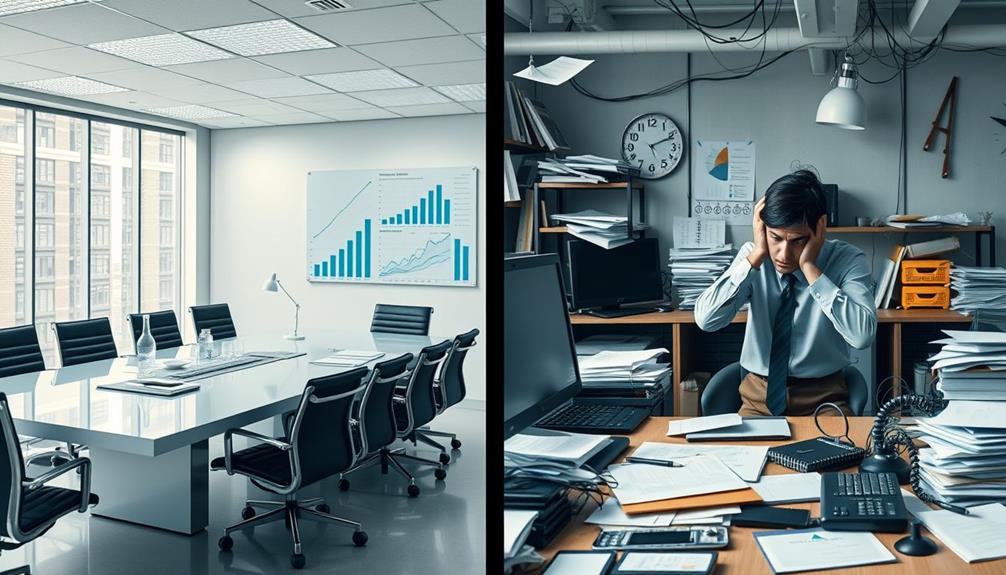Unlocking flex space is a game-changer for your business. With short-term leases, you can adapt to changing needs without the long-term commitment of traditional office spaces. It's perfect for scaling up or down as market demands shift. Assess your requirements and budget to find the right provider, whether it's Breather, LiquidSpace, or Swivel. Investing in flexible furnishings boosts productivity and fosters collaboration among your team. Plus, embracing hybrid work models can enhance employee satisfaction. There's so much more to discover about maximizing your space for success, so keep exploring your options for even greater benefits.
Key Takeaways
- Flex space offers short-term leases, allowing businesses to adapt quickly to changing space needs without long-term commitments.
- Assess your specific business requirements to choose the right type of flex space that aligns with your goals and budget.
- Utilize key providers like Breather and LiquidSpace to find versatile office solutions that suit your operational demands.
- Incorporate flexible furnishings to maximize space efficiency, encourage collaboration, and enhance overall productivity within your team.
Understanding Flex Space
Flex space is a versatile solution that offers businesses short-term commercial real estate options, allowing you to adapt quickly to changing needs. Flex space can be customized to serve a variety of functions, from coworking areas to storage solutions, making it an ideal choice for businesses seeking agility. This adaptability encourages innovation, as companies can explore creative ideas for flex spaces, such as transforming them into pop-up shops, event venues, or collaborative workspaces. By leveraging these dynamic environments, businesses can optimize their operations while staying responsive to market demands.
Unlike traditional leases that last 3-5 years, flex space leases typically range from just days to months, making it ideal for companies with fluctuating space requirements. This adaptability supports the growing trend of remote work and caters to evolving workplace dynamics.
Whether you need a temporary office for a project or a flexible workspace that can grow with your team, flex space provides the perfect environment.
With the ability to scale up or down, you can respond to market demands without the long-term commitment of conventional leases, giving you the freedom to focus on your business goals.
Identifying Your Business Needs
To effectively leverage flex space, you first need to assess your business's specific requirements and goals. Understanding what you need will help you choose the right space that aligns with your vision.
Here are four key considerations to guide you:
- Team Size: Determine the number of employees who'll need access to the space regularly.
- Budget: Establish a clear budget that includes all potential costs, including utilities and services.
- Space Type: Identify whether you need private offices, coworking areas, or meeting rooms.
- Location: Consider proximity to clients, partners, and transportation options to enhance accessibility.
Key Providers in the Market

Several key providers in the flex space market are shaping how businesses find temporary office solutions.
Breather offers app-driven, move-in ready spaces, allowing you to secure an office quickly.
LiquidSpace connects you directly with venue partners, enabling easy bookings for short-term needs.
If you're looking for customizable options, Swivel provides plug-and-play workspaces with flexible terms to suit your evolving requirements.
Additionally, the rise of Space as a Service (SaaS) enhances your access to various flex space offerings.
These providers understand the importance of adaptability, so you can focus on growing your business without the constraints of long-term leases.
Embracing their solutions can streamline your workspace strategy and help you stay competitive in today's dynamic market.
Importance of Flexible Furnishings
Adapting your workspace with flexible furnishings is essential for meeting the ever-changing demands of modern business environments. By incorporating versatile furniture, you can easily reconfigure your space to suit various needs.
Here are four key benefits of flexible furnishings:
- Space Optimization: Maximize your office layout, allowing for collaborative zones or private workstations as required.
- Cost Efficiency: Reduce overhead by investing in modular pieces that can be rearranged or repurposed instead of buying new furniture.
- Enhanced Collaboration: Foster teamwork by creating adaptable environments that encourage communication and creativity.
- Quick Setup: Facilitate rapid transitions, ensuring your workspace is ready for immediate use whenever you need it.
Embracing flexible furnishings can significantly boost your team's productivity and morale.
Emerging Trends to Watch

Emerging trends in flex space are reshaping how businesses approach their work environments, making adaptability more crucial than ever. You'll want to keep an eye on these developments to stay ahead of the curve: With a focus on hybrid work models, flex spaces in modern workplaces are being increasingly designed to prioritize collaboration, innovation, and employee well-being. The integration of technology and modular layouts is allowing companies to reconfigure spaces effortlessly to meet changing needs. As businesses seek cost-effective and scalable solutions, these flexible environments are becoming a cornerstone of future workplace strategies.
| Trend | Impact on Business | Action Needed |
|---|---|---|
| Hybrid Work Models | Boosts employee satisfaction | Design flexible spaces |
| Technology Integration | Enhances productivity | Invest in smart office solutions |
| Community-Centric Spaces | Fosters collaboration | Create networking opportunities |
| Short-Term Leases | Reduces financial risk | Embrace flexible leasing options |
Conclusion
Imagine stepping into a bright, adaptable workspace where every corner inspires creativity and collaboration.
By embracing flex space, you're not just securing an office; you're unlocking a world of possibilities for your business. This dynamic environment allows you to pivot with ease, nurture your team's growth, and stay ahead of the competition.
Don't let rigid leases hold you back—seize the opportunity to transform your workspace and watch your business thrive in today's ever-evolving landscape.










